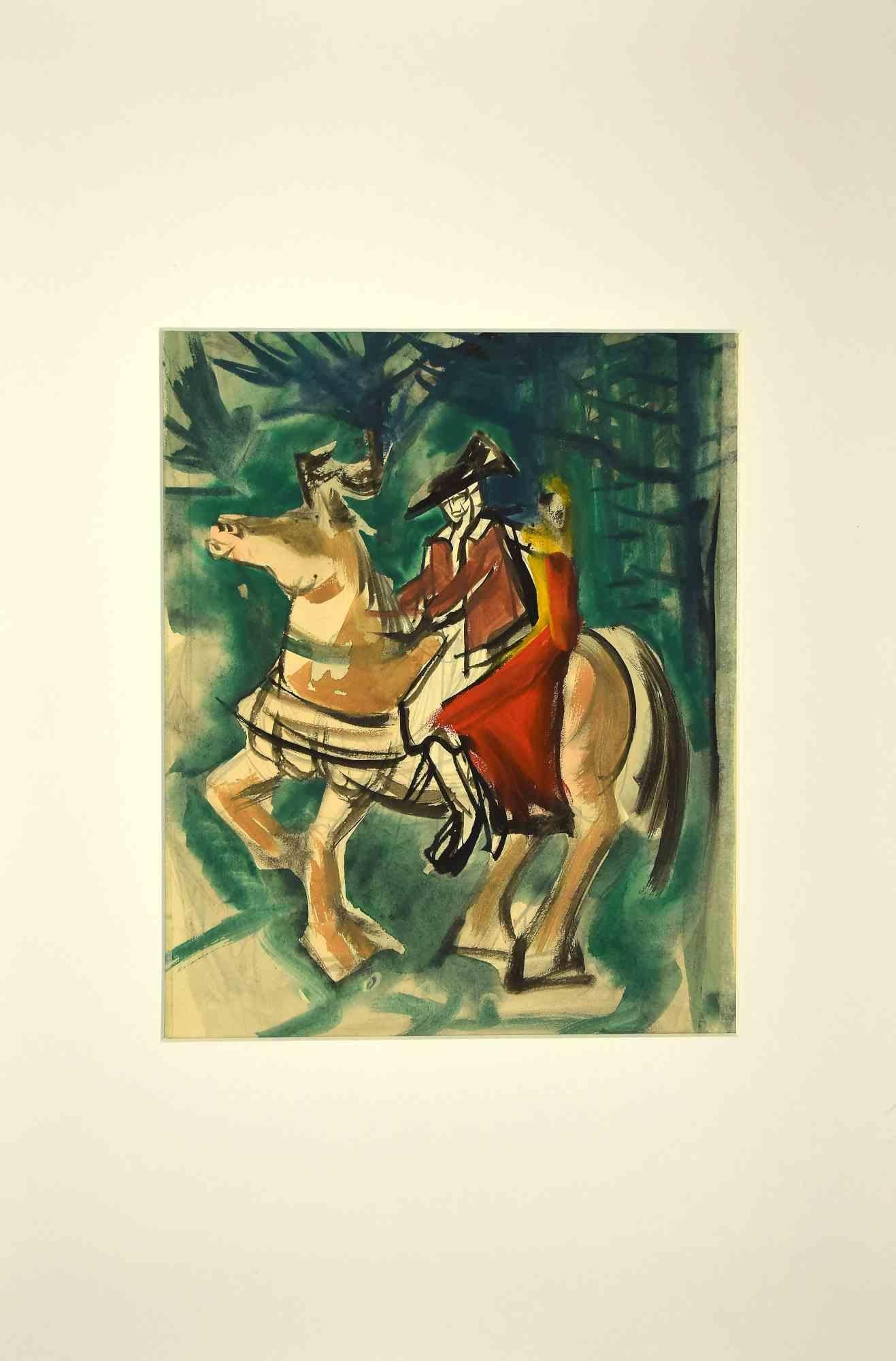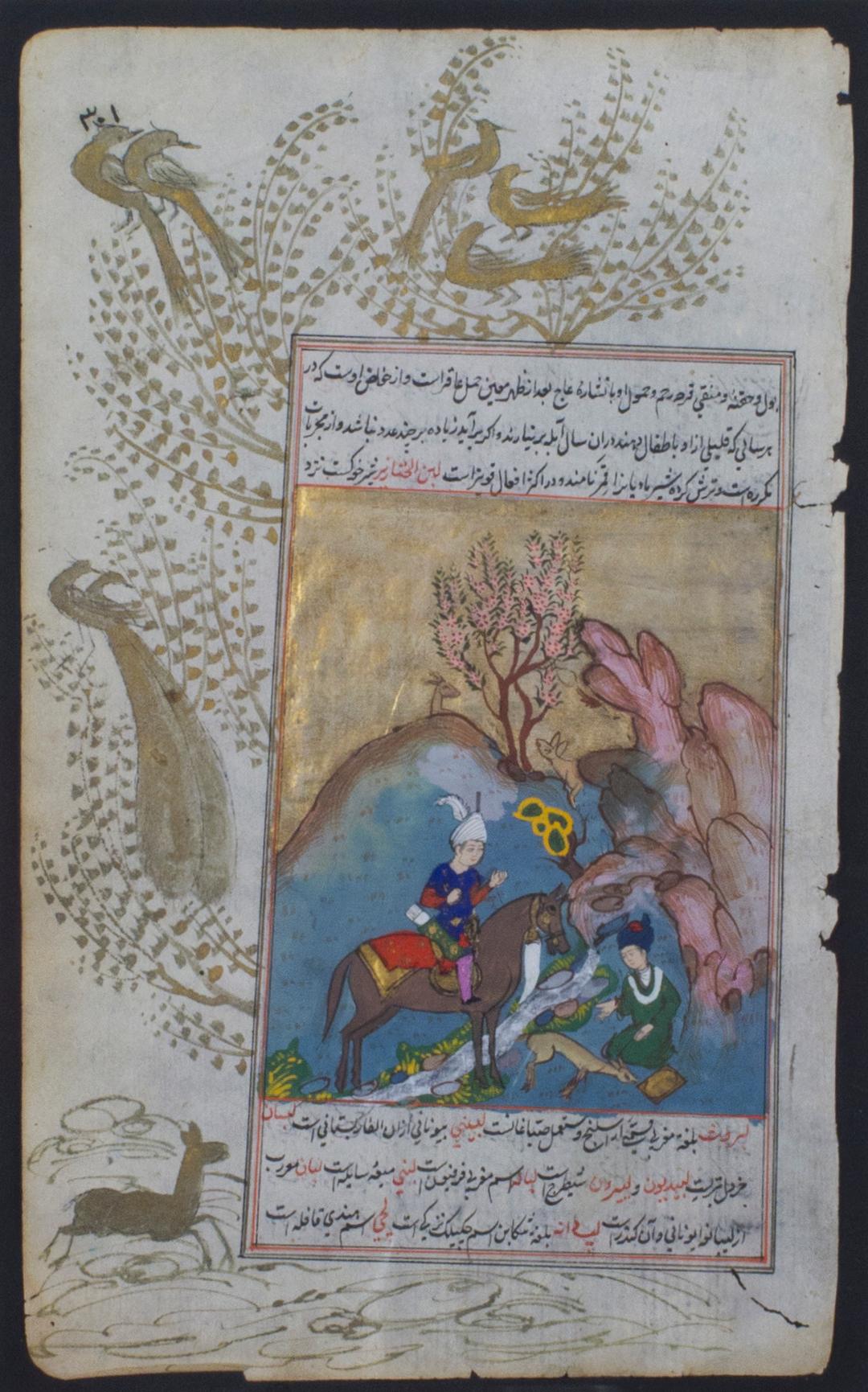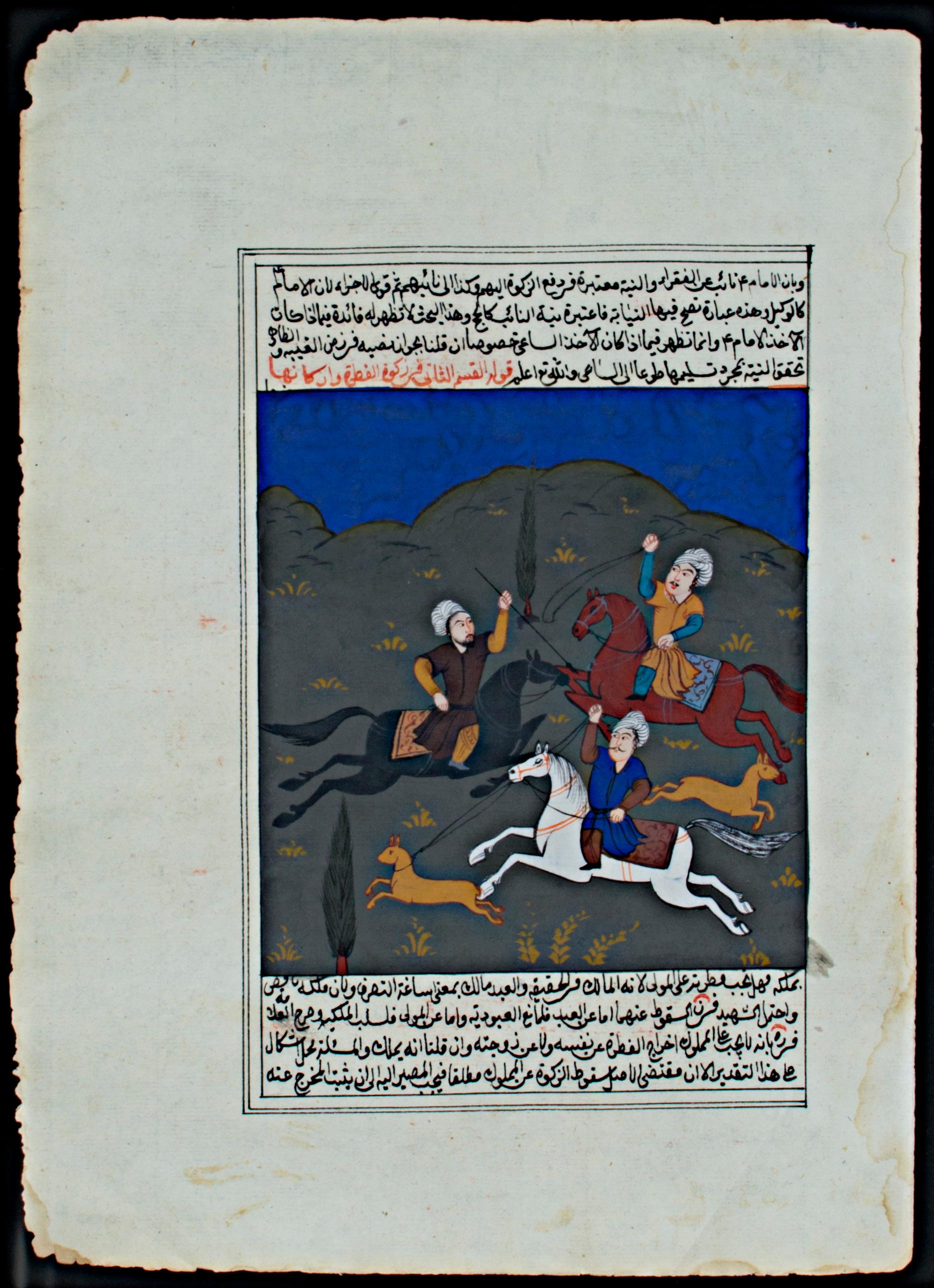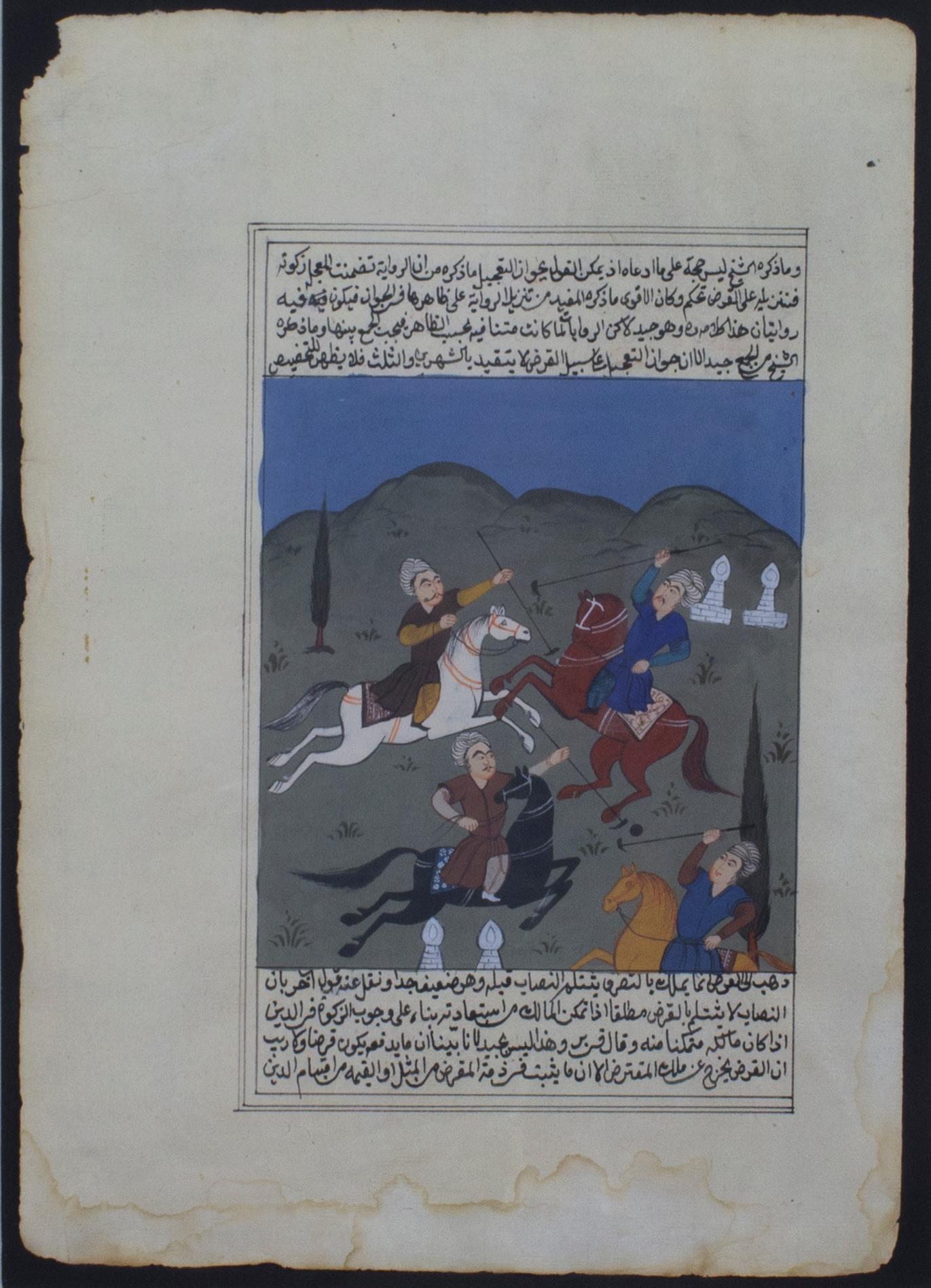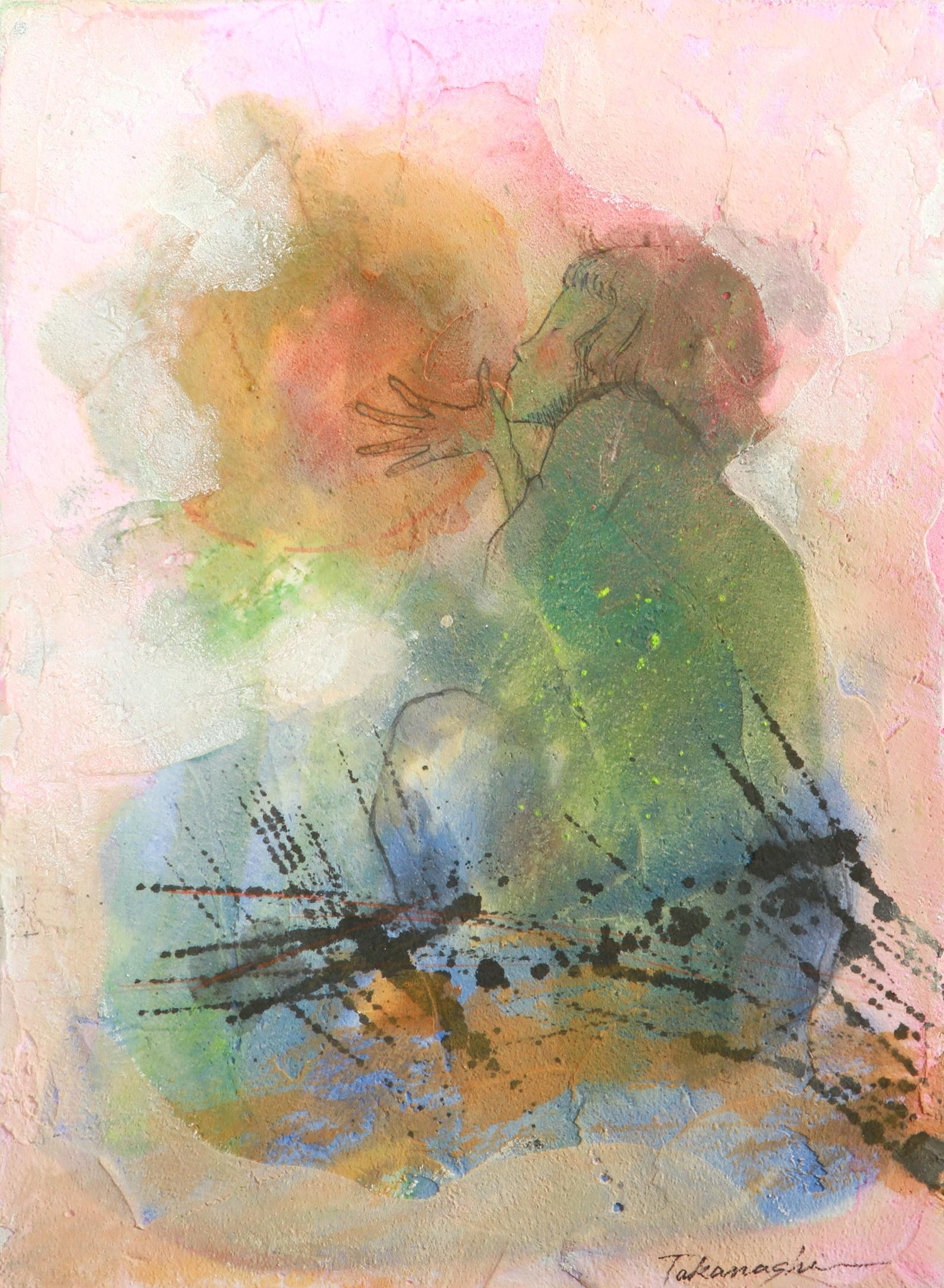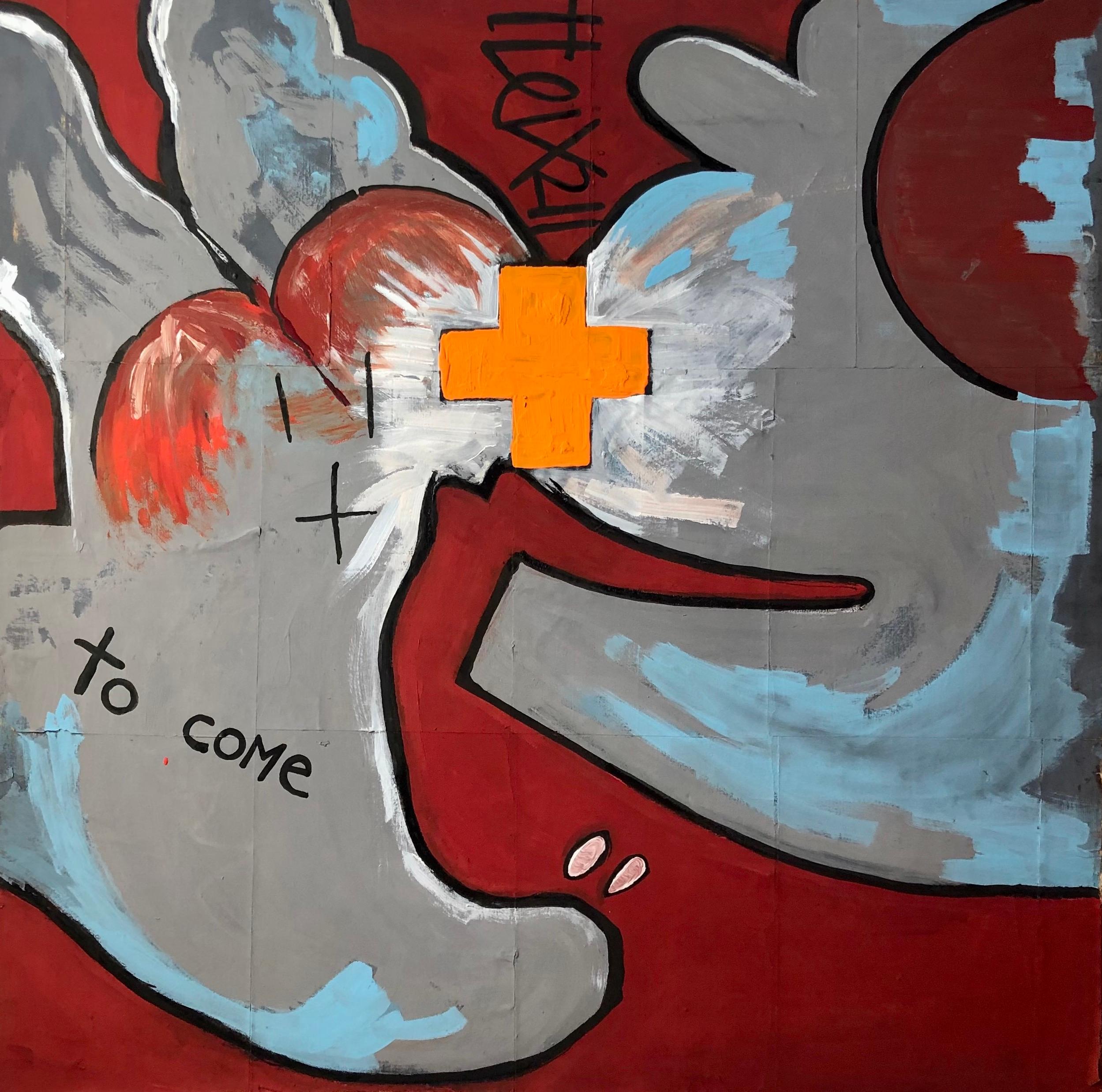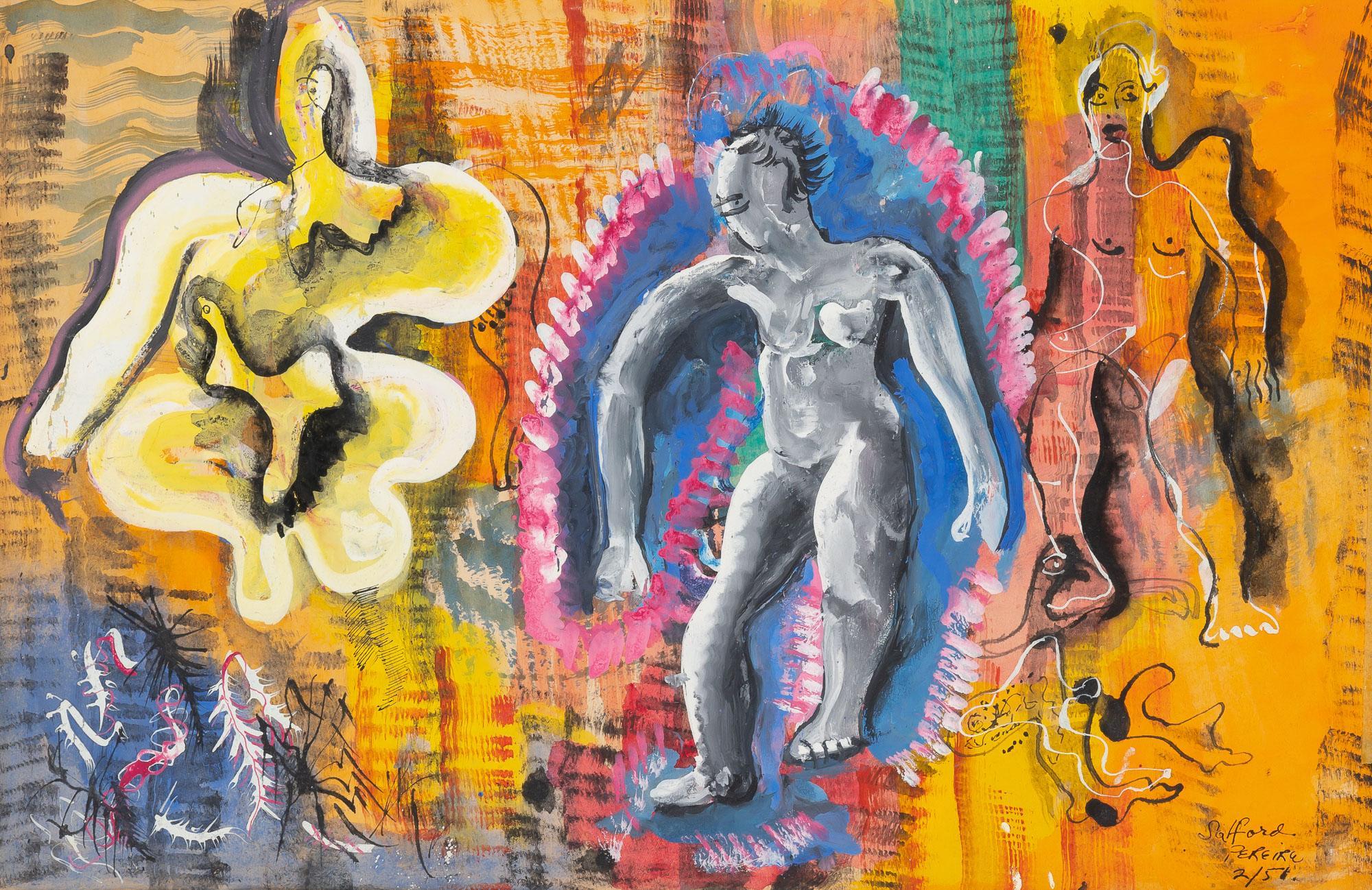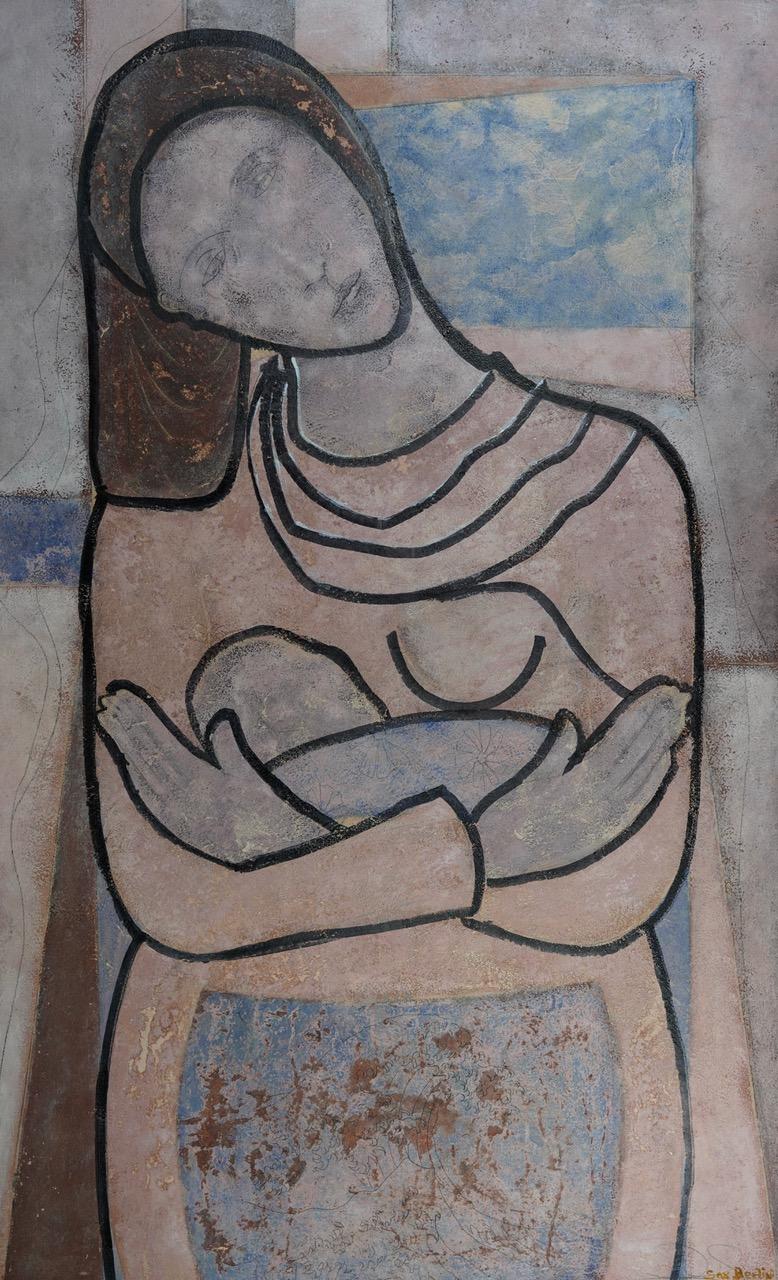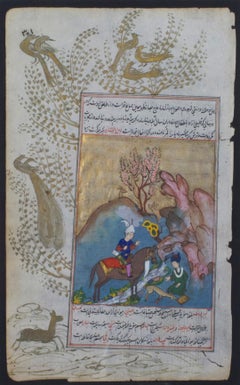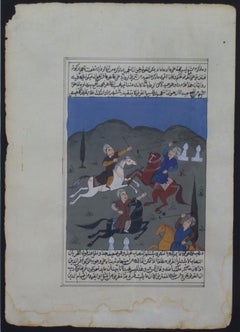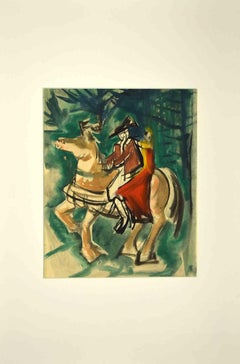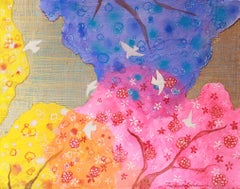
Persian Illuminated Miniature with Six Figures Playing Polo in a Landscape
View Similar Items
Want more images or videos?
Request additional images or videos from the seller
1 of 8
UnknownPersian Illuminated Miniature with Six Figures Playing Polo in a LandscapeLate 19th c.
Late 19th c.
About the Item
- Creation Year:Late 19th c.
- Dimensions:Height: 18.88 in (47.96 cm)Width: 15.25 in (38.74 cm)
- Medium:
- Period:
- Condition:Some water damage along the bottom. See images.
- Gallery Location:Milwaukee, WI
- Reference Number:Seller: 2007d1stDibs: LU60535997872
About the Seller
4.9
Platinum Seller
These expertly vetted sellers are 1stDibs' most experienced sellers and are rated highest by our customers.
Established in 1966
1stDibs seller since 2017
390 sales on 1stDibs
Typical response time: 1 hour
More From This SellerView All
- Persian Illuminated Miniature with Three Hunters on Horseback in a LandscapeLocated in Milwaukee, WIThe present illuminated folio page contains a fine miniature depicting three figures hunting while on horseback, an image meant to accompany a historic epic. During the medieval period, hunting was an important pastime of male nobility throughout the Islamic world. The Quran itself explicitly endorses hunting and the use of animals to aid in capturing prey: "Lawful to you are foodstuffs that are good to eat and any game that, at your wish, is captured by beasts of prey which train as you do dogs, according to the method that Allah has taught you, after you have spoken the name of Allah over it." (Q 6:4) Muslim princes and nobles enjoyed the chase of the prey via horseback, using bow and arrow, crossbows, and blowpipes to capture their prey Horseback riding itself trained young men in the necessary skills for armed combat and warfare, developing their speed and strength. 12 x 8.25 inches, artwork 19.75 x 15.88 inches, frame accompanied on the back with an image of the verso framed to conservation standards with a 100% rag silk-lined mat in a gold gilded frame A Persian miniature is a small Persian painting on paper, whether a book illustration or a separate work of art intended to be kept in an album of such works called a muraqqa. The techniques are broadly comparable to the Western and Byzantine traditions of miniatures in illuminated manuscripts. Although there is an equally well-established Persian tradition of wall-painting, the survival rate and state of preservation of miniatures is better, and miniatures are much the best-known form of Persian painting in the West, and many of the most important examples are in Western, or Turkish, museums. Miniature painting became a significant genre in Persian art in the 13th century, receiving Chinese influence after the Mongol conquests, and the highest point in the tradition was reached in the 15th and 16th centuries. The tradition continued, under some Western influence, after this, and has many modern exponents. The Persian miniature was the dominant influence on other Islamic miniature traditions, principally the Ottoman miniature...Category
19th Century Other Art Style Figurative Paintings
MaterialsInk, Tempera, Laid Paper
- Persian Illuminated Miniature with Two Figures Hunting in a LandscapeLocated in Milwaukee, WIThe present illuminated page was once part of a larger manuscript, as evidenced by the tears along the right edge, illustrating a story from the Islamic world. The scene presents two figures in a landscape, one on horseback and another gesturing to a fallen deer. The stylization of the landscape shows influence from the Byzantine tradition of painting, with jagged rocks jutting into a golden sky. The page contains handwritten text on both sides, and is surrounded by gold illustrations of peacocks and a running deer. 11 x 6.5 inches, artwork 18.63 x 14 inches, frame accompanied on the back with an image of the verso framed to conservation standards with a 100% rag silk-lined mat in a gold gilded frame A Persian miniature is a small Persian painting on paper, whether a book illustration or a separate work of art intended to be kept in an album of such works called a muraqqa. The techniques are broadly comparable to the Western and Byzantine traditions of miniatures in illuminated manuscripts. Although there is an equally well-established Persian tradition of wall-painting, the survival rate and state of preservation of miniatures is better, and miniatures are much the best-known form of Persian painting in the West, and many of the most important examples are in Western, or Turkish, museums. Miniature painting became a significant genre in Persian art in the 13th century, receiving Chinese influence after the Mongol conquests, and the highest point in the tradition was reached in the 15th and 16th centuries. The tradition continued, under some Western influence, after this, and has many modern exponents. The Persian miniature was the dominant influence on other Islamic miniature traditions, principally the Ottoman miniature...Category
19th Century Other Art Style Figurative Paintings
MaterialsGold Leaf
- Persian Illuminated Miniature with Four Figures Playing Polo in a LandscapeLocated in Milwaukee, WIThe present illuminated folio page contains a fine miniature depicting four figures playing polo. Polo, also called 'chagun,' was the sport of kings and princes of central Asia and Iran, and the sport probably originated there in the 6th century BCE. Polo matches appear in a large number of early Persian texts, including in the writings of the 10th century epic writer Abu l-Qasim al-Firdawsi: He describes numerous polo matches in his famous 'Shahnameh' (The Persian Book of Kings). This particular illumination also is closely related to an example held at the Smithsonian Museum of Asian Art: a folio from 'Guy u Chawgan' (The ball and the polo-mallet) which shows a polo game with the dervish and the shah. 12 x 8.25 inches, artwork 19.75 x 15.88 inches, frame accompanied on the back with an image of the verso framed to conservation standards with a 100% rag silk-lined mat in a gold gilded frame A Persian miniature is a small Persian painting on paper, whether a book illustration or a separate work of art intended to be kept in an album of such works called a muraqqa. The techniques are broadly comparable to the Western and Byzantine traditions of miniatures in illuminated manuscripts. Although there is an equally well-established Persian tradition of wall-painting, the survival rate and state of preservation of miniatures is better, and miniatures are much the best-known form of Persian painting in the West, and many of the most important examples are in Western, or Turkish, museums. Miniature painting became a significant genre in Persian art in the 13th century, receiving Chinese influence after the Mongol conquests, and the highest point in the tradition was reached in the 15th and 16th centuries. The tradition continued, under some Western influence, after this, and has many modern exponents. The Persian miniature was the dominant influence on other Islamic miniature traditions, principally the Ottoman miniature...Category
19th Century Other Art Style Figurative Paintings
MaterialsInk, Tempera, Laid Paper
- "Indian Pow-Wow, " Original Tempera Painting signed by David BarnettBy David BarnettLocated in Milwaukee, WI"Indian Pow-Wow" is an original painting in tempera, signed in the lower right. It features gestural blue outlines, decorated in shades of yellow, blue, and green. Art size: 24" x 1...Category
1960s Contemporary Figurative Paintings
MaterialsTempera
- "Rice Harvest, " Tempera on Canvas signed by Indonesian artist KelishiLocated in Milwaukee, WI"Rice Harvest" is an original tempera painting on canvas by an Indonesian artist. The signature may be "Kelishi" "M.D." or something similar and can ...Category
Early 20th Century Folk Art Figurative Paintings
MaterialsCanvas, Tempera
- "Anthropomorphic Figure, " Ink and Gouache Painting by Unknown African ArtistLocated in Milwaukee, WI"Anthropomorphic Figure" is an original ink and gouache on handmade paper by an unknown African artist. It depicts a human-snake figure. 33 1/2" x 19...Category
20th Century Figurative Paintings
MaterialsInk, Gouache
You May Also Like
- Knight and Girl - Painting - 1950sLocated in Roma, ITKnight and Girl is an original painting realized by an anonymous artist in the 1950s. Painting in tempera, watercolor, and China ink on paper. Included a Passepartout: 41 x 51 cm. ...Category
1950s Modern Mixed Media
MaterialsInk, Tempera, Watercolor
- Japanese Contemporary Art by Miyuki Takanashi - Desktop Tour-La-La-LaBy Miyuki TakanashiLocated in Paris, IDFTempera, ink, sand & egg emulsion on canvas Miyuki Takanashi is a Japanese artist born in 1961 who lives & works in Sapporo in Japan. She is graduated from Hokkaido University of Ed...Category
2010s Contemporary Figurative Paintings
MaterialsCanvas, Tempera, Ink
- Japanese Contemporary Art by Miyuki Takanashi - Forest Telling Spring 2By Miyuki TakanashiLocated in Paris, IDFTempera, ink & egg emulsion Miyuki Takanashi is a Japanese artist born in 1961 who lives & works in Sapporo in Japan. She is graduated from Hokkaido University of Education Iwamiza...Category
2010s Contemporary Figurative Paintings
MaterialsCanvas, Emulsion, Ink, Tempera
- Japanese Contemporary Art by Miyuki Takanashi - Miss SnowBy Miyuki TakanashiLocated in Paris, IDFTempera, ink & egg emulsion Miyuki Takanashi is a Japanese artist born in 1961 who lives & works in Sapporo in Japan. She is graduated from Hokkaido University of Education Iwamiza...Category
2010s Contemporary Figurative Paintings
MaterialsCanvas, Emulsion, Ink, Tempera
- Japanese Contemporary Art by Miyuki Takanashi - Wait For SpringBy Miyuki TakanashiLocated in Paris, IDFTempera, ink & egg emulsion Miyuki Takanashi is a Japanese artist born in 1961 who lives & works in Sapporo in Japan. She is graduated from Hokkaido University of Education Iwamiza...Category
2010s Contemporary Figurative Paintings
MaterialsInk, Tempera, Canvas, Emulsion
- French Contemporary Art by Claudie Baran - To ComeLocated in Paris, IDFTempera & ink on canvas Framed - 92 x 92 x 4 cmCategory
2010s Contemporary Figurative Paintings
MaterialsCanvas, Ink, Tempera
Recently Viewed
View AllMore Ways To Browse
10th Century
Six Point
Persian Painting
Persian Paintings
6th Century
Antique Book Cover
Antique Book Covers
Book Cover Antique
Art 13th Century
Match Book Art
Persian Art Painting
Antique Miniature Painting Paintings
Antique Miniature Paintings Paintings
Antique Miniature Paintings
Antique Miniature Painting
Miniature Figures
Iranian Art Large
Antique Indian Painting Paintings
